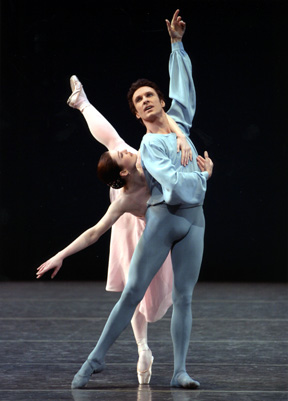Étoiles, imported and homegrown
Walpurgisnacht
Ballet/Sonatine/La Valse/Symphony in C
New York City Ballet
New York State Theater
New York, NY
April 27, 2004
by
Mary Cargill
copyright
© 2004 by Mary Cargill
published 29 April 2004
 French
night opened the New York City Ballet’s Spring Season, with French
music, French guests, a welcoming speech by the French cultural attaché,
and Balanchine choreography. There was a gala air for the whole evening,
with warm and welcoming applause for all the dancers.
French
night opened the New York City Ballet’s Spring Season, with French
music, French guests, a welcoming speech by the French cultural attaché,
and Balanchine choreography. There was a gala air for the whole evening,
with warm and welcoming applause for all the dancers.
The guest stars, Aurélie Dupont and Manuel Legris from the Paris Opera Ballet, danced Balanchine’s 1975 piano ballet Sonatine, to Ravel. The piece (made for Violette Verdy and Jean-Pierre Bonnefoux) is all perfume—a couple stands listening to the music and then begins to dance, seemingly improvising, stopping and starting, playing with various movements, repeating them, leaving the stage, returning, and then finally just spinning off. In lesser hands it could look under-choreographed, and, with its occasional mazurka outbursts, it did look a bit like pieces left over from Dances at a Gathering, but the dancers made it a private, spontaneous reverie, with random thoughts and feelings the audience was privileged to share.
The program opened with Walpurgisnacht, Gounod’s delightfully
chaste bacchanal. These women, despite their flying hair and thrilling
turns, are really cousins to the little Degas dancers, and the work has
a wonderful pastel charm. Kyra Nichols was their leader, and proved yet
again what an incandescent dancer she is, all control and luminous turns.
The off-centered playfulness of the Farrell solos is not really her style;
she made everything look gloriously, magnificently centered. Charles Askegard
was her elegantly self-effacing partner. He dances so effortlessly that
his fine support can be taken  for
granted. Lindy Mandradgieff was the second lead, and she danced as though
inspired by Nichols, with a newly expansive daring combined with a classical
control.
for
granted. Lindy Mandradgieff was the second lead, and she danced as though
inspired by Nichols, with a newly expansive daring combined with a classical
control.
Rachel Rutherford is not new to La Valse, but her partner, Robert Tewsley, was. Their first pas de deux, where their twining arms (so similar in shape yet so different in spirit from the arms of Rubies) seemed to be both dancing and speaking, was wonderfully detailed. There is no actual mime, but they conveyed both shape and sense. He seemed to be begging her to stay, and she appeared to be imagining the most wonderful jewels that he could not give her. Rutherford was no little innocent trapped by evil sophisticates, but was daring, dangerous, and wild. Tewsley watched her destruction with a helpless dignity.
Jock Soto was an implacable figure of evil (a von Rothbart in some perfect production of Swan Lake), and his first appearance, barely seen behind that dim curtain, is always a shock. Unfortunately the corps—so young and frisky in Walpurgisnacht—was equally young and frisky in La Valse, so the sophisticated, evil, seductive edge of the piece was somewhat dissipated.
Symphony in C saw the rapturously received return of Wendy Whelan in the second movement. Askegard was again her impeccably courteous partner. She danced it with the hypnotic quality she brings to so many lyrical roles, with her sense of breathing a different air, of moving in a different element. There is no human emotion in her approach, this is not a variation of Odette’s sorrow, but something felt rather than seen, a shimmer of light from a different moon. The luxurious final fall in the pas de deux seemed to reverberate like the final chord of some distant music—music of the spheres, perhaps.
The very human dancing of the third variation (Ashley Bouder and Benjamin Millepied) as a dramatic contrast, as they burst in, dancing that bounding, exultant choreography with an extraordinary flow—no pauses for extra flashy bits, just clear, pure dancing. The evening was a glorious beginning.
Photos:
First: Aurélie Dupont and Manuel Legris in Balanchine's Sonatine.
Photo by Paul Kolnik.
Second: Kyra Nichols in Balanchine's Walpurgishnachtballet.
Photo by Paul Kolnik.
Originally
published:
www.danceviewtimes.com
Volume 2, Number 15
April 29, 2004
Copyright
©2004 by Mary Cargill
|
|